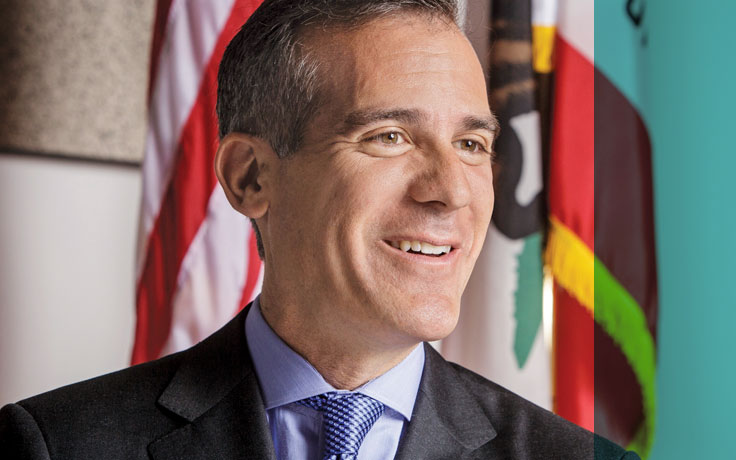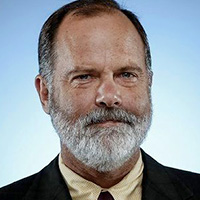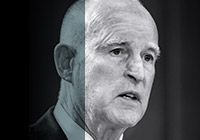ELECTED IN 2013, ERIC GARCETTI, 47, IS THE YOUNGEST MAYOR IN MODERN LOS ANGELES HISTORY. Smart and easygoing, he glides through public appearances and speaking engagements, often in both English and Spanish. To his supporters, he is a model of intelligence and promise; to his critics, he can be frustratingly hard to pin down. All of that was on display in this recent interview with Blueprint Editor-in-Chief Jim Newton.
They met in Garcetti’s City Hall office, freshly decorated in bright lights and modern art. Gone are the heavy furniture of the Richard Riordan years and the electronic photographic images that Antonio Villaraigosa displayed of himself with luminaries. The quarters today are sunnier, more whimsical, self-consciously modern. The office, in other words, suits the mayor.
The Garcetti-Newton conversation
Blueprint: We’re here to talk about water, but water — availability, conservation, storage — of course is related to climate change. What do you make of the fact that a sizable chunk of the American population, including the Republican nominee for president, denies the fact of climate change, or at least resists the notion that humanity is responsible?
Eric Garcetti: There are fewer and fewer who resist the notion that climate change is happening, and it’s less relevant whether humanity is responsible. I believe that, of course, this is man-made, but as long as you accept the reality of parched deserts, rising seas, higher temperatures, it’s a problem that, no matter what your ideology, has to be solved.
BP: Do you believe there is the political will nationally to take the kinds of steps that will be necessary to, say, hold temperature increases to less than 2 degrees Celsius?
EG: Human beings are survivalists. We will have the will we need to survive. The question is whether we do that in an even worse situation — when migration flows and conflicts and deaths are occurring as a result of climate — or will we do it when it’s only somewhat bad, like now.
And I must say that going to Paris [for the international climate summit], I haven’t felt that kind of power in a room, maybe in my life. We had a mayor from Mauritania next to a mayor from Korea next to a mayor from India next to a mayor from Europe next to me. There was so much power and consensus.
Look at the Chinese and the speed with which they went three years ago from saying, “We’re a developing nation. We’re not sure about this,” to the climate leaders’ summit that we hosted here, where they not only met their goal for 2030 but announced before Paris that two of their cities would meet the goal by 2020.
That wasn’t political pressure from us. It wasn’t the old debate of developed nations vs. developing. That was a panic that most human beings are beginning to feel and that governments are beginning to reflect.
BP: And they have the benefit of a command economy, so there’s no vote. They can move quickly.
EG: I think about that all the time. If I could just [he snaps his fingers]. Done. Antonio would have had a million trees planted in a month. [Mayor Villaraigosa famously promised to plant a million trees and never was able to achieve that, a disappointment that haunted him to the final days of his tenure.]
BP: Let’s turn to L.A. and water specifically. This is a city historically dependent on imported water. You’ve set a goal of self-sufficiency by 2050. How do you get there?
EG: I describe this as our second Mulholland moment. First we had to make peace with our past, and after literally 99 years, now 100, of fighting, we made peace with the Owens Valley and Owens Lake. That was really important, both to get more water and to deal with the issues there.
I think we all recognize the successful, but somewhat perverse, engineering system that every drop of water that falls outside the city gets engineered here in a very complicated, brilliant and complex way, but every drop of water that lands here gets rushed out to the ocean.
That’s the change. We have, actually, plenty of water. I don’t say that to be Pollyanna-ish or trite. We really do have enough water for our economy, for our drinking, for our showering, for our landscaping — even to accommodate growth. [But] there’s still a tremendous amount of waste of water. If we, in our city operations, could in two years reduce by more than 30% our water usage, [then] we’re showing that. We can meet that goal (a) just by reducing, and (b) by reusing, recycling. The equivalent of 60% of our water gets washed out to the ocean and treated every day. It’s almost drinkable. It’s not full of bad things. It’s just a little more saline. It’s very complicated to have a series of pumps and pipes to push that back to the entire city, but we could share that with the South Bay, with a water district there.
We’re looking at rebranding: from “Toilet to Tap” to “Showers to Flowers,” to do what Orange County and a lot of other places did a long time ago, but for stupid political reasons, we’ve kind of avoided that. I think we’ll do it through a combination of reuse, recycling and reduction.
BP: When you say “stupid political reasons,” my sense is that “Toilet to Tap” was wrapped up in Valley secession. Is that gone now?
EG: Yes. Nobody says it anymore. Look, a small fraction of the water you’re drinking anywhere was in somebody’s toilet or somebody’s shower.
BP: It’s all molecules.
EG: Nature does that…
BP: Do you regard the city’s acquisition of water from the Owens Valley in the early 20th century as a theft?
EG: Of course it was. It’s a theft of water, at least from Mother Nature, if not from people. We always move resources. We generate power from coal that causes cancer and asthma rates to increase on Navajo land. I was the first person to lead divestment from the Navajo plant, and now we’re completely out of it.
Human beings bring resources to wherever there are human beings, so it [the Owens River diversion to Los Angeles] might not have been unjustified, but it certainly had a huge and permanent ecological impact. The Owens Lake will never be again.
It was very important for us to make right what was wrong. We couldn’t be Los Angeles today without Mulholland’s vision, but people died from dam collapses, the ecology of entire areas was lost. Whatever we can do to make that better, we now have the tools and the wisdom to do it. That’s what makes this an exciting moment.
BP: I grew up in the Bay Area, and what we were taught was that L.A. stole Northern California’s water and then wasted it. It never occurred to me until later that San Francisco gets its water from the Sierras, too.
EG: I always tell my friends in San Francisco: “It’s a dry city. You steal your water, too. It’s just a shorter route.”
BP: Talk about the city’s goals for water use.
EG: Right now about 15% of our water is local. We’re never going to get to no imported water, but by 2025 we’re going to reduce by half the amount of water we import, and we’re trying to get to 50% local by 2035.
BP: How does that water get used?
EG: Fifty percent of our water is landscaping. You want to look at your house. People say: “I’m taking shorter showers.” That’s awesome, but let’s go through it. Fifty percent is landscaping. Half of what’s left is dishwashers and your laundry, and half of that is your toilets and your showers.
We’ve taken up 30 million square feet of grass in Los Angeles and helped pay for that in the last two years. When Jerry Brown set a goal, it was 50 million for the state. Of the land, we’re probably 2% to 3% of the state, and we’ve been responsible for 60% of his goal. And we’ve done that incredibly quickly. We’ve paid people to do that.
The biggest next thing, I think, is going to be cisterns. What Australia did for its historic drought is capture big amounts of water, keep it stored and use it throughout the year for landscaping. We have a couple pilots that DWP already paid for, some lucky winners in the Valley, where we’ve installed them. They’re smart systems, so you can control them from your phone. On days when they’re going to overflow, you can actually put the water back into the front yards. We make sure there are swales, so then it goes back into the aquifer, not into the storm drains. And when it’s dry, the cisterns let water out according to what the need is.
BP: You mentioned DWP. What’s the role of the DWP in encouraging conservation? You could imagine using rates as a tool. Charging more for water would encourage people to use less of it. But there are political consequences to that. How do you see the DWP and rates playing a role in conservation?
EG: First, rates are really important. I don’t care what the criticisms are. That has to be a part of it. We’ve just created a four-tier system; it used to be a three-tier system. So now [for] the super-users, there are consequences. They get letters. They’ll get a visit. And then they’ll get an allocation, and if they go over that, they’re going to pay fines. We didn’t always have those tools, or even know who the super-users were. Now we do.
Second, for the lower users, we’re going to see an increase of 2.4% per year for water and power for the next five years, which is manageable, I think, for people’s budgets. But more importantly, that will give us the resources to expand these programs. And I always tell people: It’s not how much the water rate is; if we bring your water bill down, who cares that the rate went up 2.4%? Your bill is 10% less because you changed the grass out, or otherwise reduced your use.
It’s a combination of money and Jewish guilt. Shame your neighbor if you see the sprinkler on too long, but we’ll also pay you to plant a beautiful, flowering front yard that isn’t just turf.
I also think that, finally, [it’s important to] coordinate a one-water strategy, which is something that I’ve brought together. It’s not just DWP but also the Bureau of Sanitation, because we have one agency that brings water in — that’s the supply — and one agency that does the two types of piping out:sewer and storm drains. We’ve really brought them together. We just won an award for being the most integrated. Some people, Mark Gold [longtime water conservation advocate, now spearheading UCLA’s Grand Challenge on sustainability] and others, have said: “Let’s create just one board.” I think there are reasons not to do that. Sanitation does other things, like trash pickup, that would make it tough to merge the two agencies, but at least they’re thinking like one team now.
We’re doing that at Tillman. We take the wastewater, and we don’t bring it to a drinkable standard yet, but we take it for golf courses in the Valley or Griffith Park. We do that at Hansen Dam, too.
We’re taking parks and building water-retention cylinders, using money from Prop. O. Every open space, green space. We’re doing that with alleyways.
Water shouldn’t just be the responsibility of Water and Power or Sanitation. The Fire Department: They use a lot of water to test and clean equipment. You might see the lawns in front of the stations looking a little browner now. The Library Department — each one of them has a role to play. Once they all own it, these goals are doable.
BP: When people talk about threats to water supply, the idea of an earthquake that would take out the levies in the Sacramento Bay Delta looms as the existential one. Do you support the governor’s plan to build the tunnels to help avert that potential catastrophe?
EG: In general, I do, though I’m very conscious of the environmental impact. I haven’t taken a formal position. Put it this way, I’m open to conversation with the governor, but it’s a little yesterday. I don’t need help from Sacramento, and I don’t need to consider threatening the environmental health of the Delta. I think we can do this ourselves.
It makes some sense if you freeze-frame today, but maybe it will become unnecessary, at least from an urban perspective. They can have an agricultural debate over whether they need it in the Central Valley.
BP: Last question: Have you been able to reduce your own water use at Getty House [the mayor’s official residence]?
EG: Absolutely. I think we cut water use by more than 30%. We’ve had 12,000 people come there. Amy [Wakeland, the mayor’s wife] has done an amazing job making it an active space. And it may not be a 30% reduction from my predecessor, because Antonio might not have had 12,000 people to the house…
BP: And Richard Riordan didn’t even live there.
EG: We turned off the fountain. We’re one of the first homes in the Hancock Park/Windsor Square area to get rid of grass in the front yard and in the parkway. We did it in the back yard, too. All the sinks have little signs from the Drop campaign. It is something that we have lived out in both my work and home environments.

























